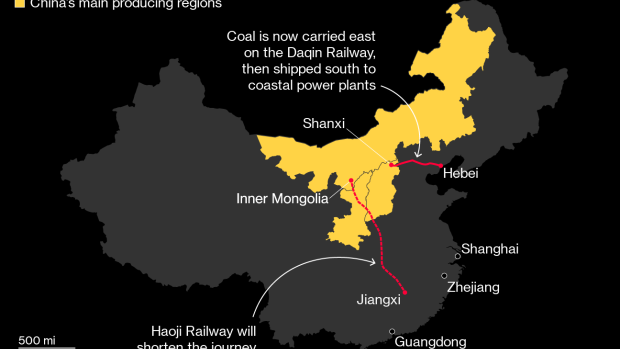Sep 19, 2019
China’s Energy Game Plan Features a Giant Coal-Hauling Rail Line
, Bloomberg News

(Bloomberg) -- There’s nothing quite like a massive coal rail to demonstrate China’s loyalty to the dirtiest of fossil fuels.
Almost a decade in the making, the nearly $30 billion Haoji Railway will start around the end of this month and eventually haul as much as 200 million tons from key producing regions in the north to consumers in the south. That’s more than Japan uses in a year and could cut China’s domestic seaborne coal trade by 10% in the long run, Fenwei Energy Information Services Co. forecasts.
In a world where governments and businesses are under pressure to leave the fossil fuel in the ground, the new rail is decidedly old-fashioned. China has pumped more money into renewable energy than any other country and is battling pollution by urging its population to burn gas instead. Yet it continues to mine and burn half the world’s coal.
“Coal will remain a dominant source of power in the next 10 years, even though it’s being gradually replaced by new energy,” said Tian Miao, an analyst at Everbright Sun Hung Kai Co. in Beijing.
One of the main reasons for building the nearly 2,000-kilometer (1,243-mile) long railway is to ease transportation bottlenecks in the domestic supply chain. China is rich in coal -- with its resource concentrated in the northern provinces of Inner Mongolia, Shanxi and Shaanxi -- but the distribution is uneven.
The country is mainly served by trains hauling supply from the west to the east, including on the Daqin Railway. Coal is delivered to ports such as Qinhuangdao and Caofeidian before getting dispatched on ships to users in the south.
To improve the efficiency of north-south transportation, China approved the construction of Haoji (previously named Menghua) in 2012, about the time its renewables growth accelerated. The country’s longest coal line will pass through Inner Mongolia, Shanxi, Shaanxi, Henan, Hubei, Hunan and Jiangxi, helping to save time and costs of moving supply over vast distances.
“The project was mulled at a time when coal was facing serious rail bottlenecks,” said Fenwei analyst Zeng Hao. “Demand for rail capacity has eased with the rise of renewable energy and environmental pressure. The rail line has more significance today as a strategic transportation channel.”
The impact on top exporters such as Indonesia and Australia may also be muted as overseas supply tends to be cheaper, said Zeng. Imports account for less than 10% of China’s coal consumption.
China has made great strides in encouraging alternative fuels, adding the most solar and wind power capacity in the world and mandating minimum levels of green energy use. However coal still provides about 60% of its energy and it will take years to change that dependence. The nation has also made energy security a priority amid the trade war with the U.S.
The startup of Haoji isn’t in conflict with China’s broader energy goals, said Ding Yihong, a chief analyst at Huaxi Securities Co. Coal plays a major role in securing the nation’s energy supply, while direct rail transportation is less polluting than diesel trucks, according to Ding.
It currently takes about 20 days to deliver coal from Shaanxi to Hunan, Hubei and Jiangxi via the main seaborne route. The new line could cut shipment time to just three days, Ding estimates. Power plants will have more flexibility in managing inventories and responding to abrupt shifts in weather conditions, which can affect electricity use.
Those three southern provinces, which currently have some of the highest coal prices, will soon receive supply directly from low-cost regions. “Cheaper supply will hit the market. Competition between coal producers will rise,” Ding said.
Total investment in Haoji is estimated at 193 billion yuan ($27 billion). Its shareholders include China State Railway Group and some of the country’s largest miners such as China Shenhua Energy Co., Inner Mongolia Yitai Coal Co. and China Coal Energy Co.
China State Railway Group didn’t respond to a fax seeking comment. Calls to the operator Mengxi Huazhong Railway Co. were unanswered. The rail will begin operation around the end of September, according to the official Xinhua News Agency, while China Coal Transport & Distribution Association said it would be on Sept. 24.
The share of coal in China’s energy mix is falling, but consumption of the fuel will continue to rise, said Teng Suizhou, marketing director of Hubei Jingzhou Coal & Port Co., which is building storage and port facilities to serve the new line. “For that reason, issues of rail delivery will need to be addressed.”
--With assistance from Hannah Dormido.
To contact Bloomberg News staff for this story: Feifei Shen in Beijing at fshen11@bloomberg.net
To contact the editors responsible for this story: Ramsey Al-Rikabi at ralrikabi@bloomberg.net, Jasmine Ng, Jason Rogers
©2019 Bloomberg L.P.


